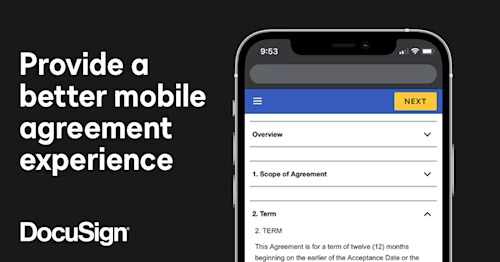
4 myths about Docusign, busted
This myth-busting article quashes any doubts you may have about how Docusign fits into the technology picture for your business.

Want to know what the six most expensive words in business are? “We’ve always done it this way.” This damaging mindset is holding some organisations back from truly leveraging the full potential of technology. Fear of change risks turning today’s success story into tomorrow’s has-been.
To help combat this fear of change – and to help organisations understand what’s needed to continually adapt in today’s rapidly evolving world – let’s explore some of the myths that are holding some back from embracing technology like Docusign.
Many of these myths could well apply to any technology within the broad remit of digital transformation; most of them trace back to an unwarranted fear of change.
Myth 1: It will take too long to implement
The thought of replacing legacy systems – whether they are digital or paper-based – with something new can be overwhelming, which is why technology projects are often placed in the ‘too hard’ basket. In fact, a Docusign implementation can take as little as 48 hours and is usually completed over the weekend to minimise downtime. Even better? Once implemented, the Docusign Agreement Cloud enables you to get things done smarter and faster than before.
Myth 2: It’s too expensive
The return on investment for technologies like Docusign is unequivocal. Indeed, a recent Forrester study found that eSignatures deliver quantified benefits: over a three-year risk-adjusted period, they save $215,378 in internal business productivity, $77,717 in sales process productivity and $168,391 in operational expenses. Plus, there are the unquantified benefits like improved customer experience, incremental revenue, security and compliance. These gains greatly outweigh the cost of implementation and licensing, with payback achieved in less than six months. To see what you can save in your business, try our Forrester ROI calculator.
Myth 3: eSignatures aren’t legally binding
Like many new technologies, eSignatures come under scrutiny from a legal perspective. Understandably so. Yet, around the world, this myth is steadily being busted. Electronic signatures are legally binding for nearly every business or personal transaction in the United States and around the world, including Australia. To learn more about the legality of eSignatures in Australia, visit our legality guide.
Myth 4: People don’t want change
Whether it’s your employees, your customers or your suppliers, it’s dangerous to assume that they share your mindset of wanting to do things the same old way. In fact, a recent Docusign study found that 13% of respondents would prefer to stick with paper (as in, make no change to their systems of agreement). Over half (55%) would prefer to complete transactions digitally. People are ready for this; indeed, many now expect it as the norm and regard having to print, scan and post documents as a burden. Read the full study here.
To see Docusign in action, [this two-minute video](<embed data-align=).
Related posts
Discover what's new with Docusign IAM or start with eSignature for free


